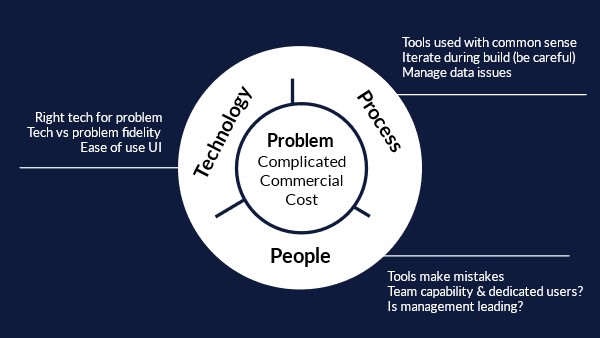
Dr Evan Shellshear, 5 October, 2023
Dr. Evan Shellshear, CEO of Ubidy, has forged a remarkable career defined by innovation and expertise in artificial intelligence. With a PhD in Game Theory, he brings nearly two decades of international experience in crafting AI solutions for a wide array of industries, collaborating with leading global companies.
Now, as an Adjunct Professor at QUT Business School, Dr. Shellshear shares his valuable insights into achieving successful AI implementation within organisations.
The Problem with Problems
As the world descended into pandemic induced chaos in March 2020, a beacon of analytics hope emerged from an unlikely place – the East Coast of New Zealand.
A team of red meat sales specialists at Alliance Group huddled trying to make sense of a world collapsing around them – and deal with tens of millions of dollars’ worth of lamb meat whose sales contracts were being cancelled faster than the virus could travel to their island home.
The challenge seemed insurmountable, however, Alliance Group mastered the looming disaster and how they climbed out of this crisis is a lesson on the power of AI and using data to make better decisions.
A big decision
A container of frozen and chilled lamb goods takes a month to reach Greece from New Zealand.
As one of Alliance’s boats bearing its cargo was approaching Greece in late March 2020, the New Zealand head of sales received the dreaded call from his Greek counterpart.
They were cancelling the entire shipment.
Restaurants were locked down, and there was nowhere to onsell the high-quality lamb. Tens of millions of dollars were at stake.
Rather than rely on his intuition or call in a highly paid opinion, in that moment the sales manager did something that most businesspeople fail to do in a crisis – he put his faith in his supply and demand optimisation engine for an answer.
In less than sixty seconds, the tool considered millions of options and analysed possibilities a human team never would have thought of and found a solution that was completely unexpected.
The optimisation engine discovered another market where the goods could be sold in two weeks and at a higher price on offer in Greece. Greece was a so-called Gold customer, which meant it received priority sales, even if the price was lower. The head of sales found a Bronze customer located in Asia who would accept the same goods at a higher price.
The Core of the Problem
While this organisation was making good data informed decisions, at the same time thousands of organisations with similar tools and similar skills were failing.
Why was one organisation able to leverage its data and others not?
The following diagram summarises my study of over 100 projects, 20 optimisation tools and half a dozen interviews to understand why some organise successfully use AI to make better decisions while others fail (this article discusses part of the People challenge):

In the case of our NZ lamb seller they were solving a problem that was amenable to analytics and so produced good, usable solutions.
What does an amenable problem look like?
It fulfils at least three things:
- It is Complicated
The problem must be not too complex but also not too simple. If there are many complex interactions with too much uncertainty, then we are likely in trouble (i.e. it will be too difficult). If the solution is always obvious, then we are also in trouble but for the opposite reason. We need to find the ‘Goldilocks’ balance of difficulty for which technical AI approaches yield accurate and useful insights.
- It made commercial sense
If the analytics tool doesn’t have an impact in a commercial way, it is unlikely to succeed. The application of AI cannot be someone’s pet project, the ROI must be there and it must be clear to the business and best of all align with the company strategy.
- The cost was well understood
The business case needs to justify the spend on the AI (e.g. leveraging an AI tool at scale will add 10% to the bottom line) or there must be a good business reason (e.g. reducing key man risk). When estimating the costs for the business case ensure you have a buffer as AI projects always cost more than you think. Even if you use external consultants to build the tools for a fixed price, don’t miss unexpected additional expenses like internal analytics translators to connect the analytics techniques developed to the business use.
What’s the takeaway?
Organisations need to make sure they are solving a suitable problem with appropriately skilled people. The best mix are a team with both maths and domain business knowledge, who understand both the commercial challenges and can apply the appropriate AI tools. A common issue that derails these activities is a lack of experience and expectations, leading to companies trying to solve the wrong types of problems and underestimating their difficulty. If you find the right problem, finding and using the right AI will be much easier.
